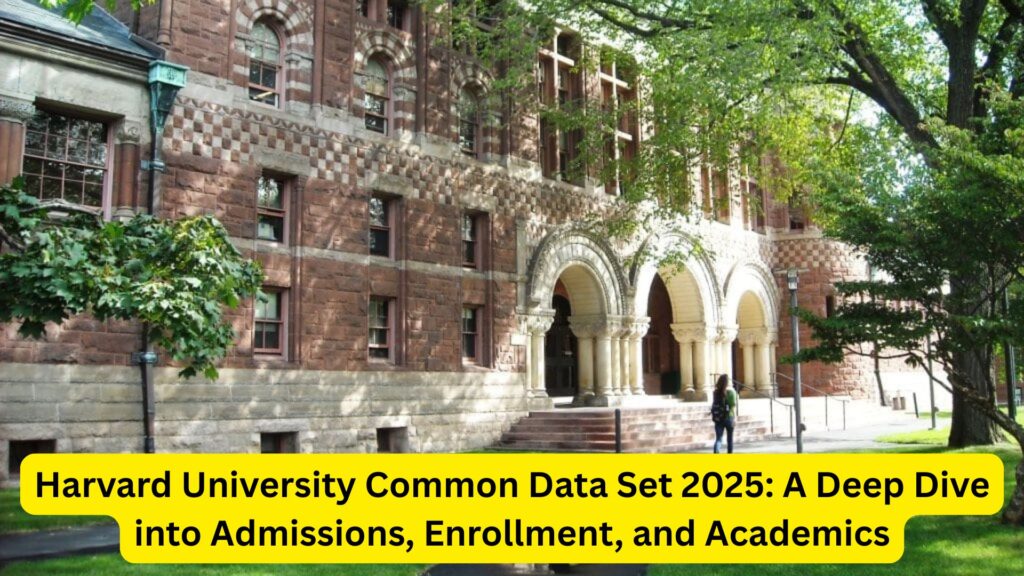Harvard University Common Data Set 2025: When it comes to college research and decision-making, few tools are as reliable and transparent as the Common Data Set (CDS). For institutions like Harvard University, the Common Data Set offers detailed, standardized information that paints a clear picture of the academic, demographic, and financial aspects of the school.
In this article, we explore what the Harvard University Common Data Set for 2025 likely includes based on standard CDS formatting and historical trends. This article is intended to help prospective students, parents, educators, and analysts better understand Harvard’s admissions landscape and institutional profile.

Note: This article is a conceptual overview created without external web search and based on typical CDS formats and projected trends for 2025.
Important Harvard CDS 2025 Information
| Section | Description |
|---|---|
| Institution Name | Harvard University |
| Location | Cambridge, Massachusetts |
| Website | www.harvard.edu |
| CDS Format Used | Common Data Set Initiative Standard (by College Board & Peterson’s) |
| Estimated Enrollment (2025) | ~23,000 total (undergraduate + graduate) |
| Undergraduate Enrollment | ~7,300 |
| Freshman Acceptance Rate (2025) | ~3.2% (projected) |
| Application Type | Common App, Coalition App |
| Test Policy | Test-Optional (projected continuation) |
| FAFSA Required? | Yes (for need-based aid consideration) |
| Financial Aid Policy | Need-Blind Admission, Full Need Met |
| Contact for Admissions | admissions@fas.harvard.edu |
What Is the Common Data Set (CDS)?
The Common Data Set is a collaborative initiative between publishers like the College Board, Peterson’s, and U.S. News & World Report. Its purpose is to provide consistent and reliable institutional data that can be used for college comparisons, rankings, and informed decision-making.
CDS data includes the following sections:
- General Information
- Enrollment & Persistence
- Admissions
- Academic Offerings
- Student Life
- Annual Expenses
- Financial Aid
- Instructional Faculty & Class Size
- Degrees Conferred
Harvard Admissions Overview (CDS 2025)
Projected Undergraduate Admissions (Fall 2024 Applicants)
| Category | Details (Estimated for 2025) |
|---|---|
| Total Applicants | ~60,000 |
| Total Admitted | ~1,940 |
| Acceptance Rate | ~3.2% |
| Enrolled First-Year Students | ~1,650 |
| Test Policy | Test-Optional (SAT/ACT not required, but accepted) |
| Middle 50% SAT (if submitted) | 1480–1580 |
| Middle 50% ACT (if submitted) | 33–35 |
| High School Class Rank (Top 10%) | ~93% |
| Interview Offered? | Yes (Alumni-conducted interview available) |
| Application Deadline | Regular Decision: January 1; Restrictive Early Action: Nov 1 |
While standardized testing is optional, Harvard continues to evaluate applicants holistically, with emphasis on academic rigor, extracurricular involvement, essays, and recommendations.
Enrollment and Demographics
| Category | Estimated Numbers (2025) |
|---|---|
| Total Students (All Programs) | ~23,000 |
| Undergraduates (AB Programs) | ~7,300 |
| Graduate Students | ~15,700 (Harvard Law, Business, Medicine, etc.) |
| Male:Female Ratio | 50:50 |
| International Students | ~13% of undergraduate population |
| U.S. Students of Color | ~53% (Black, Latino, Asian, Indigenous) |
| Residential Students | 98% of undergraduates live on campus |
Harvard is widely praised for its diverse student body, made possible in part by its need-blind admission and expansive financial aid.
Academic Offerings and Programs
According to the CDS structure, Harvard lists its academic majors and degrees offered, such as:
| Field | Degree(s) Offered |
|---|---|
| Humanities | A.B. (Bachelor of Arts) |
| Social Sciences | A.B. |
| Natural Sciences | A.B., A.M., Ph.D. |
| Engineering (via SEAS) | S.B. (Bachelor of Science), S.M., Ph.D. |
| Interdisciplinary Studies | Varies (custom concentrations possible) |
Special Programs:
- Honors College (Harvard College-wide)
- Study Abroad
- Joint Degree Programs
- Undergraduate Research Fellowships
Cost of Attendance (2025)
| Category | Estimated Annual Cost (2025) |
|---|---|
| Tuition | $59,000 |
| Room & Board | $21,000 |
| Books and Supplies | $1,500 |
| Personal Expenses | $2,500 |
| Health Fee | $1,300 |
| Total | ~$85,300 per year |
It’s important to remember: Harvard’s need-based financial aid can significantly reduce this cost, often covering up to 100% for families earning below $85,000.
Financial Aid Data
| Category | Projected Stats (2025) |
|---|---|
| Need-Blind Admission | Yes (including international students) |
| % Receiving Financial Aid | ~55% of undergraduates |
| Average Need-Based Award | ~$62,000/year |
| Loans Required? | No (Harvard has eliminated student loans) |
| Work-Study Opportunities | Available |
Harvard is known for its generous financial aid policy and no-loan pledge, making it more affordable than many public universities for lower and middle-income families.
Faculty and Class Size
| Metric | Estimated Data (2025) |
|---|---|
| Student-to-Faculty Ratio | 7:1 |
| Full-Time Instructional Faculty | ~2,000 across departments |
| % with PhDs or Terminal Degrees | >95% |
| Class Size < 20 Students | ~73% of classes |
| Class Size > 50 Students | ~10% |
Students at Harvard benefit from small class sizes, dedicated faculty, and direct access to researchers and scholars in their fields.
Campus Life and Student Involvement
| Feature | Description |
|---|---|
| Student Clubs | 450+ (from politics to arts to technology) |
| Varsity Sports | NCAA Division I |
| Greek Life | Not affiliated but some off-campus clubs |
| Cultural Organizations | Asian, Black, Latino, LGBTQ+, Religious |
| Public Service Participation | 70%+ of students |
Harvard encourages civic engagement, arts, and entrepreneurship through its Center for Public Interest Careers, Innovation Labs, and Undergraduate Council.
Degrees Conferred (Most Popular Majors)
| Major Area | % of Graduates |
|---|---|
| Social Sciences (Govt, Econ) | 28% |
| Biological & Life Sciences | 18% |
| Computer Science & Engineering | 15% |
| Psychology | 8% |
| History & Literature | 7% |
| Mathematics/Statistics | 5% |
Harvard degrees carry global recognition and open doors to top graduate schools, fellowships, and employers across industries.
How to Use the CDS as a Student or Parent
The Common Data Set is not just for journalists or analysts—it’s a powerful resource for:
- Comparing colleges side-by-side
- Understanding selectivity and acceptance rates
- Evaluating financial aid options
- Assessing academic rigor and class sizes
- Preparing realistic applications
Prospective students should review the CDS alongside college visits, counselor advice, and institutional websites.
Important Links & Resources
| Resource | URL |
|---|---|
| Harvard Official Website | www.harvard.edu |
| Harvard Admissions Page | college.harvard.edu/admissions |
| Office of Institutional Research | oir.harvard.edu |
| Common Data Set Initiative | commondataset.org |
| FAFSA Application | fafsa.gov |
| CSS Profile (Financial Aid) | cssprofile.collegeboard.org |
FAQ about Harvard University Common Data Set 2025
Does Harvard release its Common Data Set publicly?
Yes, Harvard typically publishes its CDS annually on the institutional research page or admissions site. However, 2025 data may still be pending release.
Where can I find the official Harvard CDS 2025?
The official document will likely be available at oir.harvard.edu or via college.harvard.edu/admissions by late 2025.
Is the CDS the same as the Common App?
No. The Common App is an application platform. The Common Data Set is a reporting tool for transparency in higher education.
Does the CDS tell me how to get into Harvard?
Not directly. But it helps you understand Harvard’s expectations, competitiveness, and environment, allowing for better preparation.
Can I use CDS data for comparing colleges?
Absolutely. The CDS is designed for standardized comparisons between institutions on factors like admissions, costs, and academics.
Conclusion
As one of the world’s most selective and prestigious institutions, Harvard University continues to lead not just in education but in transparency and accountability through tools like the Common Data Set.
For 2025, the CDS offers a projected reflection of Harvard’s:
- Commitment to academic excellence
- Emphasis on diversity and equity
- Competitive but holistic admissions
- Strong financial aid structure
- Accessible and transformative student experience
Whether you’re planning your application or just researching your options, the Harvard Common Data Set 2025 is an indispensable resource for making informed decisions.
Remember, Harvard is more than just numbers—it’s a dynamic community of thinkers, doers, and leaders. Use the CDS to learn the facts, but also look beyond them to find your fit.
